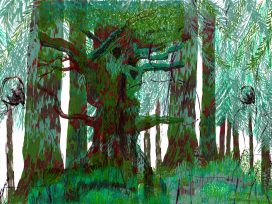
On the border between Poland and Belarus, the Forest has become the subject of a humanitarian crisis. An artist’s report, based on meetings with activists and refugees, charts this contested space. Poetry honours those lost in transit.
Should artists feel any obligation towards their local community in a global world of markets and international exhibitions? For every one whose work appears on the pages of international art magazines, there are hundreds who opt to “stay at home”, says a Latvian cultural critic.
Is it possible, by any stretch of the imagination, to claim that the contemporary visual art we see displayed at major art festivals such as the Kassel documenta or the Biennales of Venice and Sao Paulo, or that we find hung in millions of galleries from Tokyo and Shanghai to Seattle and Los Angeles, publicised in fashionable art magazines and gallery catalogues, and touted on the Internet has such a quality as “national identity”?
The question may sound absurd, even somewhat dated. Liberal and leftist academic doctrine, as expounded by the likes of Benedict Anderson, Ernest Gellner, Antony Smith, Eric Hobsbawm and other champion providers of quotations, not to mention the legions of those who take advantage of said quotes, claims that national identity is a “social construct” which, in today’s global village, no longer has any justification or prospects. There are, of course, exceptions: if art, or that which “contextually” is called art, comes from Kosovo’s democrats or from Chechen fighters, from the Tamil Tigers or persecuted Ugandan homosexuals, then the “world community” nods its head and discerns identity: a relationship to a specific time and place.
Yet if that art comes from Serbia’s majority native population, from patriotic or even, God forbid, Orthodox Russian society, from Sri Lanka’s ruling establishment or Uganda’s Christian majority, then should it even get so far as to be dignified with the epithet “art”, it is chauvinistic, racist, xenophobic, separatist art.
In a word, in the roundabout of contemporary art, which for almost half a century now has creaked and groaned around the brains of critics, theorists, gallery owners and others close to these circles, everything is fairly clear. We have heard it repeated countless times that art in today’s world is a form of criticism – of governing institutions, of social practices and of ideology – directed at everything that endangers human rights. The threat to these comes from lurking imperialism in all its manifestations, manifestations that could, for example, include the mere existence on this earth of the USA or Israel. Or even the regrettable fact that inequalities between men and women, discrimination between white and black, between conventional families and gay couples, between Christians and Muslims still exist.
No one seems to know how things really are.
If one follows the quality mass media – CNN, the New York Times, the Guardian, Diena, Latvijas Radio for instance – as well as a variety of artistic, cultural and self-styled philosophical journals, one is left with the impression that “humanity” is predominantly “progressive” and that only a handful of reactionaries continue to lurk in the shadows muttering about their “values”. It’s almost as if we live in a society that embodies the triumph of democratic socialism – forgive me, I should have said of liberalism or liberal democracy. And if there is still somewhere in the world, somewhere like Afghanistan, where things are not quite as we would like them, then we shall see that they soon are.
But if the world’s dominant ideology really is like this, then artists should be obliged to fulfil what that ideology so often enjoins: criticise it unsparingly. Artists would be under an obligation to unmask “modern” academic, media, political and cultural “standards” and to praise regionalism, the close-knit family and clan units, and the tendency to exclude the outside world implied in the English idiom “my home is my castle”. Art should aspire to be of use to the artist’s village, parish or local community, to take part in a national identity “project” as an individual form of protest against the universal and the global.
But nothing of the kind happens. And that can be evidence of only one thing: that the democratic world of civil society invoked by the media is in reality a destructive vision of how things must be, conjured up by a narrow interest group without the slightest connection to the interests and needs of the six billion residents of this planet. The majority of people still feel closely connected to – or identify with – their native language and the processes of thought within their given nationality. A person with this type of belonging or identity, for example a Latvian, who looks at a painting of the market in Filharmonijas Square in Vecriga [Old Riga, the historic heart of the town – ed.], will intuitively be able to distinguish whether the work was done by a Latvian rather than a Russian or Uzbek. On the other hand, it is highly unlikely that the same Latvian, confronted with a painting of the Ponte Vecchio in Florence, will have the faintest idea whether it was painted by a Kurd or an Italian. Each to his and her own.
One could say that some nations and peoples are more creative than others: the French “invent” impressionism and the rest of Europe copies it. But so what? For the average Latvian, Vilhelms Purvitis [1872-1945, landscape painter and educator who founded the Latvian Academy of Art and was its rector from 1919 to 1934 – ed.] will always be more comprehensible than Alfred Sisley, [1839-1899, an English impressionist landscape painter – ed.], just as the painters of the Nagybanya school [an artists’ colony founded in the town of that name in Hungary in the late-nineteenth century – ed.] are recognisable to the average Hungarian. Each has his or her own “Purvitis”.
But what impact does this have on contemporary art? It is evident that the materials or medium of art – a grainy video image, a pile of polyethylene sheets, a stack of planks – is every bit as international, even supranational, as a charcoal pencil, oil paint or a block of granite. Nevertheless, art historians are not ashamed to speak about “Flemish” or “Spanish” or “German” painting, even when the subject, like the medium, is the same in all three paintings and all of them hang on the walls of the Russian Hermitage or the Metropolitan Museum in the US or some such. Americans have no qualms about claiming abstract expressionism and Pop Art as “US art” regardless of the artist or its place of origin.
Why, then, should we be concerned about national identity in art? Possibly because “contemporary art”, even in its most interesting and distinguished manifestations, is quite simply of no relevance whatsoever to “the people of the village, parish or community” – or even, were one to be so lucky as to gain such recognition, beyond the borders of the village. “Contemporary art” is generically closer to the flow of global finance, the global communications system we have come to know as the “Internet” or, at its most extreme, to merchandising – the exchange of goods and services where the goods and services themselves have no meaning, purpose or value except that conferred by who buys what and how much is paid in the course of the transaction.
Of course, not all who have the desire, the skill, the education and training to realise their creative aspirations have any interest in becoming part of this “distributive network of goods and services”; of those who do, few succeed. Thousands get into the grandiose fabrication of “contemporary art” and their work appears on the title pages of art magazines and in the promotional literature of art galleries. But hundreds of thousands more never appear in such places opting to stay where they should be: in their own national identity, eschewing the global for the local – the village of their birth.
Published 27 April 2010
Original in Latvian
Translated by
Uldis Bruns
First published by Studija 71 (2010)
Contributed by Studija © Peteris Bankovskis / Studija / Eurozine
PDF/PRINTSubscribe to know what’s worth thinking about.

On the border between Poland and Belarus, the Forest has become the subject of a humanitarian crisis. An artist’s report, based on meetings with activists and refugees, charts this contested space. Poetry honours those lost in transit.

The white saviour, driven by a moral mission, benefits from the oppression they claim to resist. Reactions to the plight of ‘victims’ often fail to translate into concrete actions, leaving those in need of care begging for sympathy. Could acknowledgement of individual complexity to the point of mystery alter this dynamic?